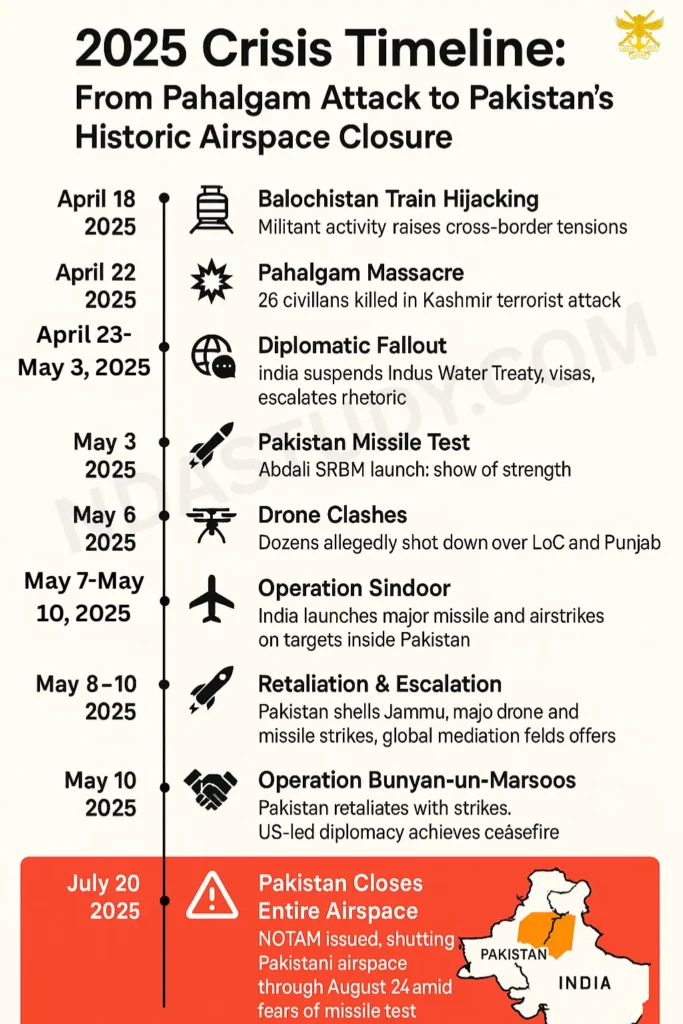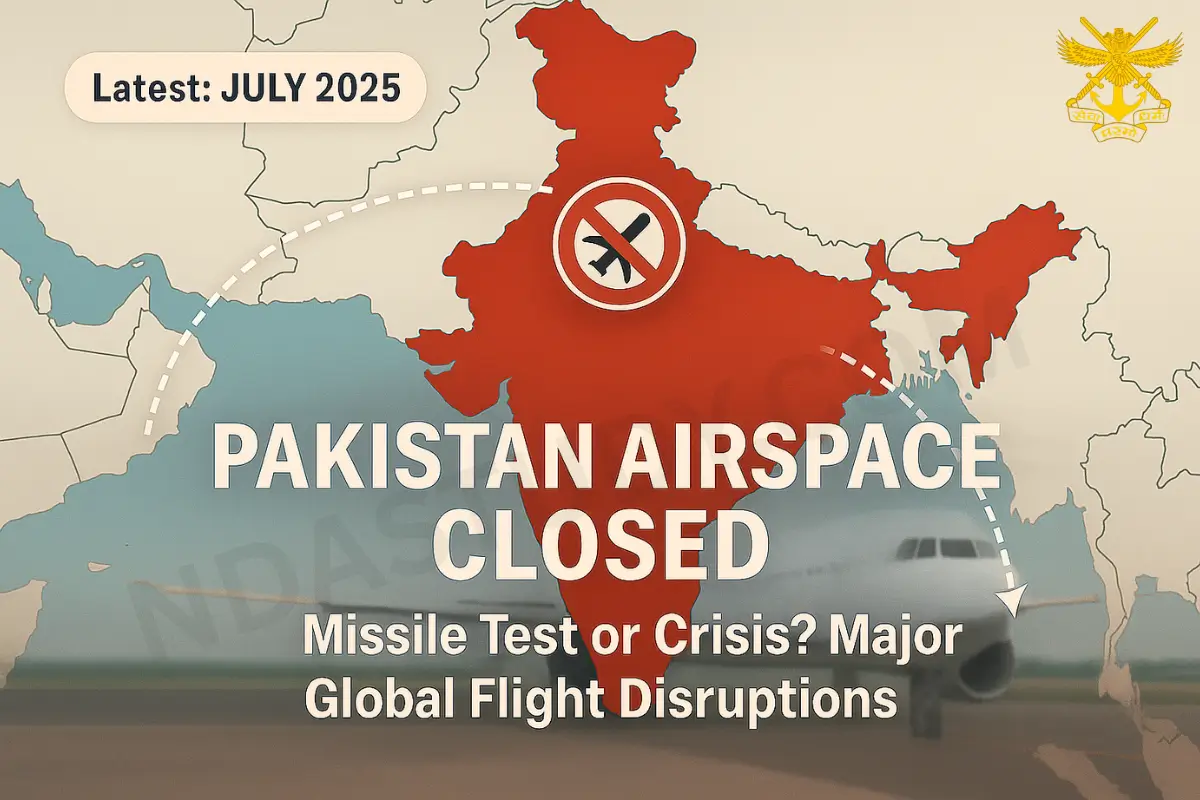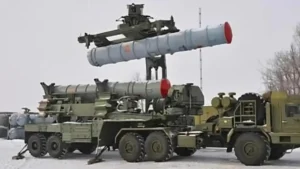Pakistan Closes Entire Airspace, triggering a wave of global concern over possible military escalation in South Asia. On July 20, 2025, Pakistan issued an official NOTAM (Notice to Airmen) announcing a full airspace closure to all Indian civilian and military aircraft, effective until August 24, 2025. This unexpected and sweeping move comes amid heightened tensions following recent cross-border hostilities and speculation of an impending missile test or large-scale military drill. The airspace ban affects all major commercial flight routes between India, the Middle East, and Europe, forcing airlines to reroute and adding hours to travel times, crippling global aviation traffic.
It also represents a sharp escalation in the ongoing India-Pakistan standoff, especially as it follows closely after Operation Sindoor and continued repairs at the strategic Rahim Yar Khan Airbase. Experts believe that such a wide-ranging airspace closure is rarely enforceable without significant military planning, suggesting deeper security concerns beyond routine exercises. As Pakistan closes its entire airspace, defence analysts, global airlines, and governments are now on high alert, monitoring the situation for potential escalation, diplomatic fallout, and broader regional instability.
What is a NOTAM? Why Is Pakistan Shutting Its Airspace?
A NOTAM (Notice to Airmen) is an official bulletin issued by a country’s aviation authority to inform pilots of urgent or temporary changes—including airspace restrictions, hazards, or procedure updates—that are critical for safe and legal flight operations. NOTAMs are essential for flight planning and are created to ensure that aviation professionals are always aware of current risks or operational changes.
This week, Pakistan closes Entire Airspace with a seeping NOTAM effective from July 20 through August 24, 2025. The directive covers all airspace over Pakistan, barring Indian civilian and military aircraft, and has forced the rerouting of regional and international flights. Officials have not confirmed the exact trigger, but analysts believe the timing points to possible missile tests or a major military drill involving extensive air operations. What makes this NOTAM stand out is its unprecedented scale and timing, encompassing the entire country’s airspace and coinciding with recent cross-border tensions. Unlike routine, short-term airspace notices, this closure signals heightened military readiness and carries significant implications for regional stability, aviation security, and global connectivity.
Operation Sindoor and Recent Escalations
In the months leading up to the current crisis, Pakistan has closed its entire airspace amid sharply rising tensions, which have been fueled by a series of violent and historic events. The escalation began on April 22, 2025, with a devastating terrorist attack in Pahalgam, India, that killed 26 civilians and triggered intense accusations of cross-border terrorism. On May 7, India responded by launching Operation Sindoor, a coordinated missile and airstrike campaign targeting nine terrorist infrastructure sites across Pakistan and Pakistan-administered Kashmir. This marked a significant turning point in Indo-Pak relations.

The operation employed advanced munitions and precise aerial strikes, although Pakistani sources reported collateral damage to civilian sites. In retaliation, Pakistan initiated heavy shelling, drone strikes, and its own military operation, called “Bunyan-un-Marsoos,” before a fragile ceasefire was declared on May 10. Throughout this period, the Rahim Yar Khan Airbase became a critical hub, suffering damage from targeted strikes and undergoing urgent repairs, which directly impacted Pakistan’s air defence capabilities.
India’s Response & Regional Escalation Risks
India responded swiftly after Pakistan Closes Entire Airspace, implementing strong military, diplomatic, and aviation countermeasures. Within hours, India extended its own NOTAM, maintaining the closure of Indian airspace to all Pakistani-operated, owned, or leased civilian and military flights until July 24, 2025—a restriction that has now seen multiple renewals since its original imposition on April 30, following the Pahalgam terror attack. Beyond aviation bans, India reinforced its air defence preparedness and reiterated earlier diplomatic moves, including suspending the Indus Waters Treaty, closing the Attari border crossing, and downgrading diplomatic ties.
This reciprocal airspace ban has left both nations’ aviation sectors disrupted, forced major airlines to reroute, and strained commercial and people-to-people links. Experts note that while such tit-for-tat closures have historical precedent, the current cycle is the most prolonged since major crises like the Balakot strikes, signalling a rising risk of further escalation or miscalculation rather than mere routine posturing. As tensions compound, observers remain alert for any signs of breakthrough or dangerous confrontation.
Impacts on Airline, Trade & Global Aviation
The closure of Pakistan’s airspace has disrupted international flights, trade, and the global aviation network. More than 800 weekly flights from Indian airlines are facing longer routes, delays, and higher costs as they avoid Pakistani airspace. The most affected routes are from Delhi to Europe, the UK, Central Asia, and North America, with flights now going over the Arabian Sea or Iran. This change adds one to four hours of travel time and increases fuel use.
Air India, IndiGo, and SpiceJet have to make refuelling stops, reduce the number of passengers on flights, or even cancel some routes. Passengers will see higher airfares, which have gone up by 8% to 12%. Indian airlines will also struggle to compete since foreign airlines can still use faster or cheaper routes. The air crisis between India and Pakistan affects global travel too. Airlines worldwide face scheduling difficulties, cargo deliveries are delayed, and business travel between Asia and Europe is challenged. Long term, Pakistan will lose overflight fees and its reputation as a reliable transit hub, making it harder for international airlines to partner with it. This will worsen the economic impact of the crisis.
What’s Next for South Asia?
The future of South Asia is unclear as the region faces repeated tensions and unstable ceasefires. There are several possible outcomes: the sides might start talking again, show more military force, or make a serious mistake. So far, U.S.-led mediation and military hotlines have prevented a full-blown war, but mistrust runs deep, and reactions happen quickly. Both sides remain alert, and experts warn that even a small incident could lead to conflict because of the crowded geography and advanced weapons.
There is still a chance for peace through strong communication hotlines, informal dialogues, and rebuilding trust. However, the danger of escalation is real, especially as retaliatory actions shape regional decisions.
Public advisory: Keep informed with reliable news and official statements. Stay alert, as even slight changes in language or military actions can have big impacts on regional peace and global air travel.
Operation Sindoor & Rahim Yar Khan Recap
Operation Sindoor, launched by India on May 7, 2025, marked a pivotal escalation in the 2025 India–Pakistan conflict. In response to the Pahalgam terror attack, India targeted nine terror infrastructure sites in Pakistan and Pakistan-administered Kashmir using advanced precision munitions, including SCALP and HAMMER bombs, BrahMos cruise missiles, and Israeli loitering munitions. The rapid campaign showcased India’s shift toward domestic capability and hardline counterterrorism, with heavy retaliation from Pakistan leading to intense cross-border shelling, drone clashes, and the subsequent Operation Bunyan-un-Marsoos.
FAQs on Pakistan Closes Entire Airspace
1. What is a NOTAM, and why does it matter?
A NOTAM, or Notice to Airmen, is an official alert issued by aviation authorities to inform pilots and airlines of crucial, temporary changes in airspace operations, navigation, or safety. NOTAMs matter because they help protect passengers and crew by warning of restricted zones, new hazards, or urgent security situations. The latest NOTAM behind the Pakistan airspace closure is especially significant, as it blocks flights across major international corridors and signals possible elevated military activity.
2. What areas are impacted by the Pakistan airspace closure?
The Pakistan airspace closure directly affects all airspace controlled by Pakistan, including the Lahore and Karachi Flight Information Regions (FIRs). Indian airlines—and all Indian military and civilian aircraft—are banned from entering or transiting Pakistani airspace until August 24, 2025. International flights between India and Europe, Central Asia, and North America are most impacted, as they must reroute across longer, costlier paths.
3. How does this closure compare with previous events?
This current shutdown is the most far-reaching since the February-August 2019 closure, which halted all overflights amid intense India–Pakistan conflict. Unlike brief, localised disruptions, both 2019 and 2025 NOTAMs cover the entire country’s airspace and last for weeks or months, causing major global aviation delays. The ongoing cycle of bans and extensions sets a new benchmark for regional and international disruption.
4. How has India responded to Pakistan’s NOTAM?
India immediately imposed reciprocal measures—banning all Pakistani airlines, and military and leased aircraft from Indian airspace, a policy first activated on April 30, 2025, and now extended through July 24, 2025. India’s response also included major diplomatic downgrades, border closures, and trade restrictions, making this a broader standoff that extends far beyond aviation.
5. What should travellers and airlines do?
Travellers should check with their airlines for the latest schedule changes, possible delays, and route adjustments on flights crossing South Asia. Major carriers are rerouting planes around the region, which may raise costs and increase journey times. Airlines and cargo operators are advised to monitor official NOTAM updates and government safety advisories, as the situation could change rapidly with little notice. Travellers are strongly urged to remain flexible and stay updated for real-time developments on the ongoing closure.
Amid this military standoff, Rahim Yar Khan Airbase suffered significant damage during retaliatory strikes, disrupting Pakistan’s aerial defence network and necessitating weeks of urgent repairs. These events destabilised air operations, directly influencing the current full airspace closure. For more in-depth analysis, explore our detailed breakdowns on Operation Sindoor and Rahim Yar Khan airbase aftermath, which reveal how these flashpoints set the stage for Pakistan’s unprecedented NOTAM and ongoing crisis.
Author’s Word: Pakistan Closes Entire Airspace
As regional tensions hit new highs, Pakistan Closes Entire Airspace stands out as a turning point for South Asian stability and international air travel. This unprecedented move disrupts hundreds of flight routes, delays trade, and signals deepening mistrust between India and Pakistan. With each extension, the stakes for aviation safety and regional peace only grow. For travellers and businesses, staying informed through verified updates is more crucial than ever.
We’ll keep tracking every development on this crisis. For real-time updates, expert breakdowns, and in-depth analysis, don’t forget to share this article, subscribe to our newsletter, and follow us on social media. Your engagement helps spread vital information as events continue to unfold.
Stay Tuned & Stay Connected!












